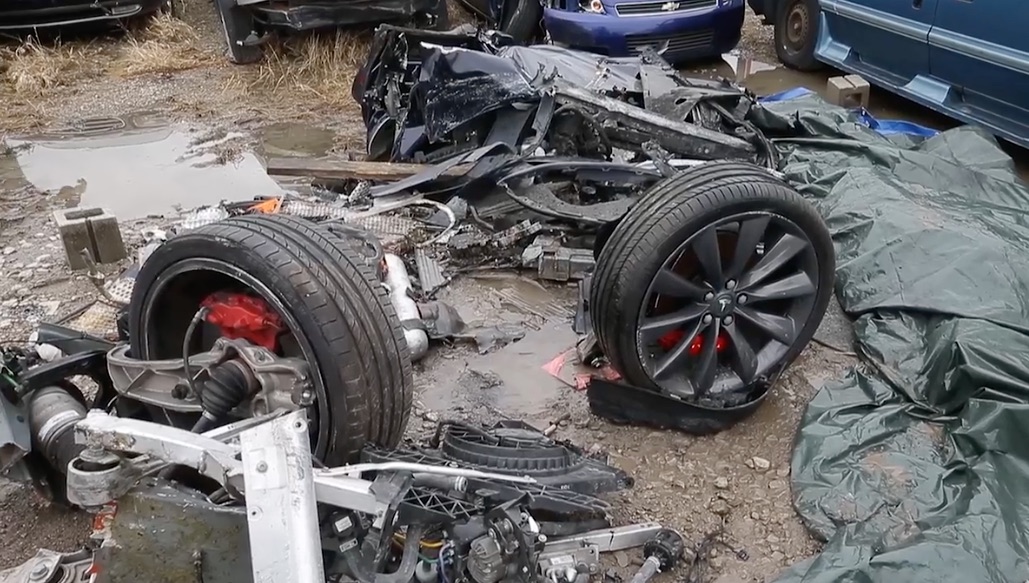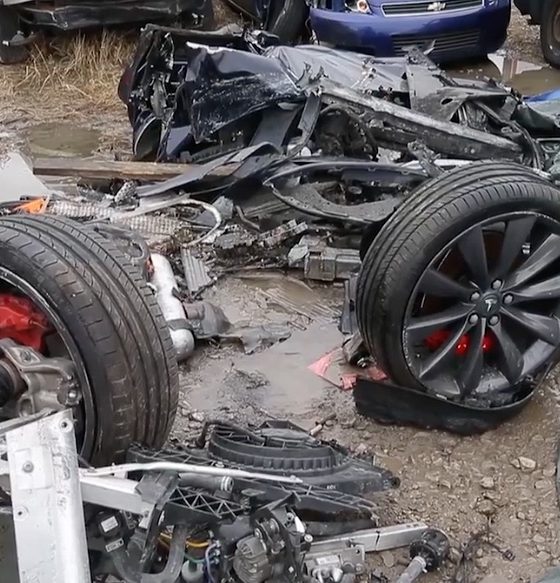

News
Vandals destroy Tesla Model S, X in Amsterdam in deliberate burning incident
A Tesla Model S and X recently met an unfortunate end in Vondelstraat, Amsterdam. The two electric vehicles, both of which were parked on the street, were set on fire by vandals in an act that witnesses described as deliberate and planned.
The two ill-fated Teslas were parked within 100 meters of each other. According to a local resident who witnessed the incident, the vandals who committed the attack on the electric vehicles were clearly focused on the cars.
“That’s no coincidence. It’s an expensive car. One was here, I saw it from my balcony. The other around the corner at the Vondel Church. Another car was damaged, but that was because it was so close,” the local resident said, according to an Echt Amsterdams Nieuws report.
Considering that the act of aggression against the Teslas seemed to be deliberate, the damage to the two vehicles was extensive. The Model S, for one, lost its entire hood and significant part of its body to the fire, while the Model X got its whole front end burned off. As could be seen in photos from the unfortunate event, a vehicle parked close to the Model X was also burned in the attack.
Photos available at Echt Amsterdams Nieuws. A video of the burning aftermath can be found below.
While the act committed by the vandals was shocking and incredibly dangerous, the owner of one of the electric vehicles took the incident in stride. In a statement to Echt Amsterdams Nieuws, the Tesla owner revealed that he was able to capture clips of the vandals on video. The owner, who remains anonymous as of writing, further stated that he was confident that his electric car’s insurance would cover the cost of the damages incurred in the attack. He does, however, regret the unexpected demise of his Tesla, especially since the vehicle was still new.
“My wife woke me because the car’s alarm went off. We soon realized that it was a fire because of the smoke and smell. The children were sleeping, so we were shocked. We have camera images of the two arsonists, which we shared with the police. Apparently, someone is not a fan of progress. He (the Tesla) is fairly new, and I only had him for four months, but I think I am well insured.”
Incidents of vandalism against Tesla’s vehicles and infrastructure have happened in the past. A horrible keying attack on a Tesla back in 2016, where a vandal from the Netherlands aggressively damaged almost all of the panels of a Model S. Messages insulting the electric car were also etched all over the electric car’s bodywork.
Back in November 2016, we also covered a vandalism incident at a Supercharger station connecting LA to Las Vegas. The vandals, who initiated their attack ahead of the Thanksgiving weekend, were successful at temporarily disabling the station’s chargers. As soon as reports emerged of the vandalism, however, Tesla acted quickly, repairing the Supercharger facility and getting things back to working order.

News
Tesla FSD fleet is nearing 7 billion total miles, including 2.5 billion city miles
As can be seen on Tesla’s official FSD webpage, vehicles equipped with the system have now navigated over 6.99 billion miles.

Tesla’s Full Self-Driving (Supervised) fleet is closing in on almost 7 billion total miles driven, as per data posted by the company on its official FSD webpage.
These figures hint at the massive scale of data fueling Tesla’s rapid FSD improvements, which have been quite notable as of late.
FSD mileage milestones
As can be seen on Tesla’s official FSD webpage, vehicles equipped with the system have now navigated over 6.99 billion miles. Tesla owner and avid FSD tester Whole Mars Catalog also shared a screenshot indicating that from the nearly 7 billion miles traveled by the FSD fleet, more than 2.5 billion miles were driven inside cities.
City miles are particularly valuable for complex urban scenarios like unprotected turns, pedestrian interactions, and traffic lights. This is also the difference-maker for FSD, as only complex solutions, such as Waymo’s self-driving taxis, operate similarly on inner-city streets. And even then, incidents such as the San Francisco blackouts have proven challenging for sensor-rich vehicles like Waymos.
Tesla’s data edge
Tesla has a number of advantages in the autonomous vehicle sector, one of which is the size of its fleet and the number of vehicles training FSD on real-world roads. Tesla’s nearly 7 billion FSD miles then allow the company to roll out updates that make its vehicles behave like they are being driven by experienced drivers, even if they are operating on their own.
So notable are Tesla’s improvements to FSD that NVIDIA Director of Robotics Jim Fan, after experiencing FSD v14, noted that the system is the first AI that passes what he described as a “Physical Turing Test.”
“Despite knowing exactly how robot learning works, I still find it magical watching the steering wheel turn by itself. First it feels surreal, next it becomes routine. Then, like the smartphone, taking it away actively hurts. This is how humanity gets rewired and glued to god-like technologies,” Fan wrote in a post on X.
News
Tesla starts showing how FSD will change lives in Europe
Local officials tested the system on narrow country roads and were impressed by FSD’s smooth, human-like driving, with some calling the service a game-changer for everyday life in areas that are far from urban centers.

Tesla has launched Europe’s first public shuttle service using Full Self-Driving (Supervised) in the rural Eifelkreis Bitburg-Prüm region of Germany, demonstrating how the technology can restore independence and mobility for people who struggle with limited transport options.
Local officials tested the system on narrow country roads and were impressed by FSD’s smooth, human-like driving, with some calling the service a game-changer for everyday life in areas that are far from urban centers.
Officials see real impact on rural residents
Arzfeld Mayor Johannes Kuhl and District Administrator Andreas Kruppert personally tested the Tesla shuttle service. This allowed them to see just how well FSD navigated winding lanes and rural roads confidently. Kruppert said, “Autonomous driving sounds like science fiction to many, but we simply see here that it works totally well in rural regions too.” Kuhl, for his part, also noted that FSD “feels like a very experienced driver.”
The pilot complements the area’s “Citizen Bus” program, which provides on-demand rides for elderly residents who can no longer drive themselves. Tesla Europe shared a video of a demonstration of the service, highlighting how FSD gives people their freedom back, even in places where public transport is not as prevalent.
What the Ministry for Economic Affairs and Transport says
Rhineland-Palatinate’s Minister Daniela Schmitt supported the project, praising the collaboration that made this “first of its kind in Europe” possible. As per the ministry, the rural rollout for the service shows FSD’s potential beyond major cities, and it delivers tangible benefits like grocery runs, doctor visits, and social connections for isolated residents.
“Reliable and flexible mobility is especially vital in rural areas. With the launch of a shuttle service using self-driving vehicles (FSD supervised) by Tesla in the Eifelkreis Bitburg-Prüm, an innovative pilot project is now getting underway that complements local community bus services. It is the first project of its kind in Europe.
“The result is a real gain for rural mobility: greater accessibility, more flexibility and tangible benefits for everyday life. A strong signal for innovation, cooperation and future-oriented mobility beyond urban centers,” the ministry wrote in a LinkedIn post.
News
Tesla China quietly posts Robotaxi-related job listing
Tesla China is currently seeking a Low Voltage Electrical Engineer to work on circuit board design for the company’s autonomous vehicles.

Tesla has posted a new job listing in Shanghai explicitly tied to its Robotaxi program, fueling speculation that the company is preparing to launch its dedicated autonomous ride-hailing service in China.
As noted in the listing, Tesla China is currently seeking a Low Voltage Electrical Engineer to work on circuit board design for the company’s autonomous vehicles.
Robotaxi-specific role
The listing, which was shared on social media platform X by industry watcher @tslaming, suggested that Tesla China is looking to fill the role urgently. The job listing itself specifically mentions that the person hired for the role will be working on the Low Voltage Hardware team, which would design the circuit boards that would serve as the nervous system of the Robotaxi.
Key tasks for the role, as indicated in the job listing, include collaboration with PCB layout, firmware, mechanical, program management, and validation teams, among other responsibilities. The role is based in Shanghai.
China Robotaxi launch
China represents a massive potential market for robotaxis, with its dense urban centers and supportive policies in select cities. Tesla has limited permission to roll out FSD in the country, though despite this, its vehicles have been hailed as among the best in the market when it comes to autonomous features. So far, at least, it appears that China supports Tesla’s FSD and Robotaxi rollout.
This was hinted at in November, when Tesla brought the Cybercab to the 8th China International Import Expo (CIIE) in Shanghai, marking the first time that the autonomous two-seater was brought to the Asia-Pacific region. The vehicle, despite not having a release date in China, received a significant amount of interest among the event’s attendees.








